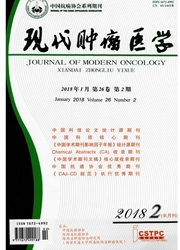

 中文摘要:
中文摘要:
目的:探讨不同止血方法对腹腔镜下卵巢肿瘤剥除术后卵巢功能的影响。方法:本研究选择2011年5月-2013年3月我院收治的92例卵巢良性肿瘤患者,根据在腹腔镜下卵巢肿瘤剥除术中所采取的止血方法的不同将其分为观察组与对照组,观察组患者采用双极电凝止血法,对照组患者采用缝合的止血方法。观察两组患者手术时间、出血量、住院天数、体内性激素[卵泡刺激素(FSH)、雌二醇(E2)、黄体生成素(LH)]水平及手术后月经情况的变化。结果:观察组患者的手术时间明显低于对照组,出血量及住院天数也显著性低于对照组,组间比较差异均具有统计学意义(P〈0.05);两组患者手术前性激素(FSH、E2、LH)水平进行比较无显著性差异(P〉0.05),手术后两组性激素水平比较有显著性差异(P〈0.05);观察组的月经正常率为93.5%,对照组为71.7%,观察组正常率明显高于对照组,两组比较有统计学意义(P〈0.05)。结论:采用电凝的止血方法与传统的手术缝合方法相比,前者可以有效保持卵巢的正常生理功能,降低手术对患者的副作用,值得进一步研究。
 英文摘要:
英文摘要:
Objective:To investigate the effects of different methods of hemostasis strip after laparoscopic ovarian cancer ovarian function. Methods:Objects of study were chosen from May 2011 to March 2013 in our hospital 92 ca- ses of benign ovarian tumor patients, depending on the method of hemostasis laparoscopic ovarian cystectomy were di- vided into observation group and control group. The observation group were treated with bipolar coagulation of haemo- stasis,in the control group were treated with suture haemostasis. To observe operative time, blood loss and length of hospital stay, sex hormone [ follicle stimulating hormone ( FSH ), estradiol ( E2 ) and luteinizing hormone (LH) ] lev- els, changes in menstruation in two groups after surgery. Results:In observation group operative time was significantly lower than the control group, the amount of bleeding and the number of days of hospitalization was significantly lower than the control group, the difference was statistically significant ( P 〈 0.05 ) ; In the two groups before surgery hor- mone ( FSH, E2, LH) levels had no significant difference ( P 〉 0.05 ), sex hormone levels after surgery was significant different (P 〈 0.05 ). Menstruation normal rate of the observation group was 93.5 %, in the control group was 71.7 % ( P 〈 0.05 ). Conclusion: Hemostatic coagulation method compared with traditional surgical treatment, the former can be effectively maintain normal physiological function of the ovaries, to reduce the side effects of surgery.
 同期刊论文项目
同期刊论文项目
 同项目期刊论文
同项目期刊论文
 期刊信息
期刊信息
